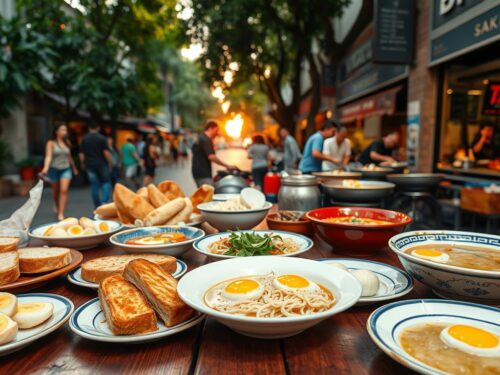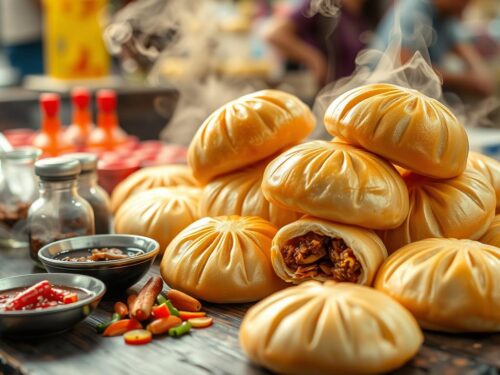Few dishes capture the essence of Singaporean street food like a steaming bowl of fishball noodles. This beloved comfort dish combines springy noodles, bouncy fishballs, and aromatic broth—a harmony of textures and flavors that locals crave.
From bustling market food centres to quiet neighborhood stalls, each vendor adds their unique touch. Some focus on Teochew-style lightness, while others deliver bold Fuzhou-inspired versions. Spicy variations also draw crowds for those who love an extra kick.
We evaluated spots based on freshness, broth depth, and authenticity. Whether you’re after famous names or hidden gems, this guide covers diverse styles across the city. Check out our top-rated mee pok spots for more noodle adventures.
Key Takeaways
- Fishball noodles are a staple in local hawker culture.
- Stalls vary by style—Teochew, Fuzhou, or spicy.
- Freshness and texture are critical for quality.
- Options range from iconic stalls to under-the-radar finds.
- Broth balance defines the dish’s authenticity.
Introduction to Singapore’s Fish Ball Noodle Scene
Singapore’s hawker culture thrives on simple yet flavorful dishes, with fishball noodles holding a special place in local hearts. This beloved comfort food traces its roots to Teochew immigrants, who brought recipes for springy noodles and handmade fishballs in the early 20th century. Today, over 1,000 stalls serve this dish nationwide—proof of its enduring appeal.
Variations abound. Some prefer dry versions tossed in savory sauce, while others crave soup-based bowls with aromatic broth. Noodle choices range from flat mee pok to thin kway teow, each adding unique texture. Heritage brands like Ming Fa Fishball, founded in 1946, still craft their fishballs daily using traditional methods.
Modern twists keep the dish fresh. Halal-certified stalls cater to diverse diets, while 24-hour outlets satisfy late-night cravings. Whether enjoyed for breakfast or lunch, this dish remains a flavorful nod to Singapore’s culinary evolution. For more on local favorites, explore our guide to beloved comfort food across the island.
What Makes the Best Fish Ball Noodle?
Quality hinges on three pillars: ingredients, texture, and freshness. From the bounce of handmade fishballs to the depth of broth, each element plays a vital role. Let’s break down what elevates a bowl from ordinary to extraordinary.
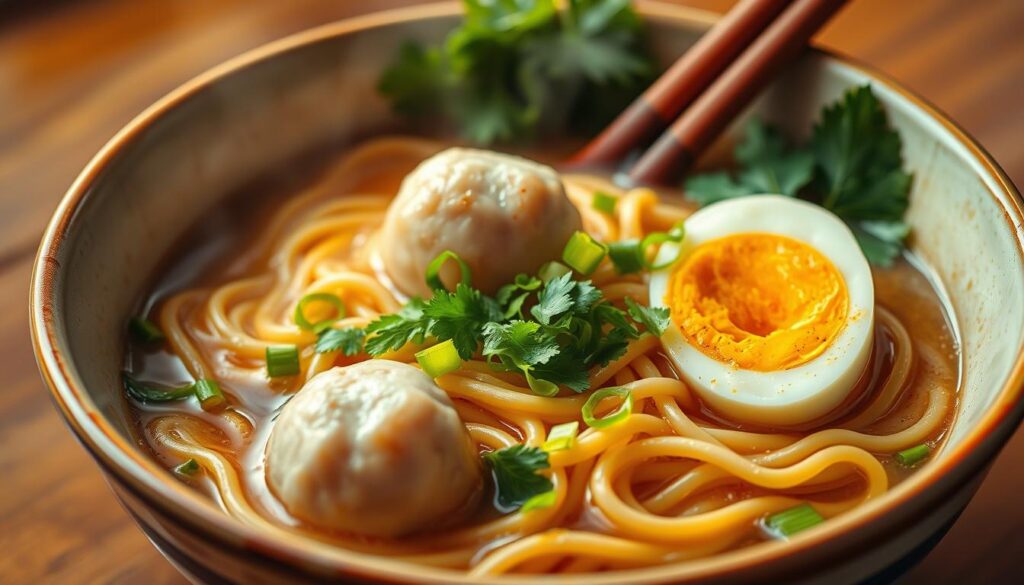
Key Ingredients to Look For
Handmade fishballs should contain at least 80% fish meat—yellowtail is a premium choice. Avoid rubbery, machine-made versions. Ming Fa’s Fuzhou-style stuffed fishballs, filled with minced pork, are game-changers.
Broth matters too. A clear, umami-rich base simmered with bones and dried flounder beats bland shortcuts. Ru Ji Kitchen’s al dente mee pok tossed in fragrant pork lard crisps proves simplicity shines.
Texture and Flavor Profiles
The ideal bite offers contrast: springy fishballs, chewy noodles, and crunchy lard bits. Song Kee’s sambal-keluak sauce adds a spicy, earthy twist. A dash of vinegar cuts through richness, balancing flavors.
The Importance of Freshness
Stalls like Li Xin use daily-caught fish for bouncier textures. Broth should never taste reheated—signs of a lazy batch. Look for stalls that cook in small batches to ensure consistency.
Our Top Picks for the Best Fish Ball Noodle in Singapore
Queues tell the story—here’s where locals flock for authenticity. These nine spots master the balance of texture, broth, and heritage. Whether you crave spice or simplicity, there’s a bowl fishball noodles waiting to impress.
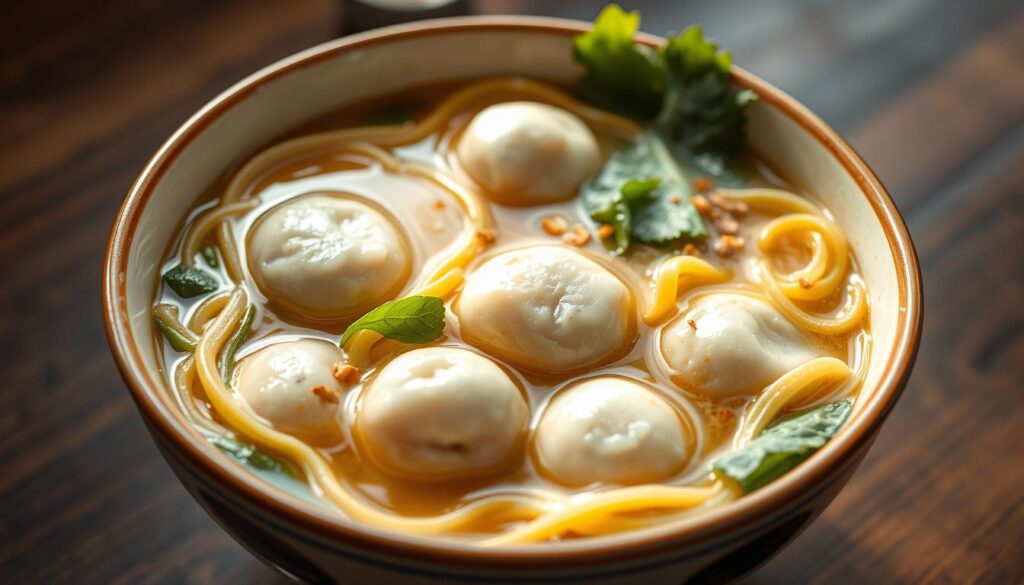
Ru Ji Kitchen: The Early Bird’s Delight
Open only from 7 AM to 1 PM at Holland Drive, Ru Ji’s irregular-shaped fishballs are praised for their bounce. Their dry mee pok, tossed in pork lard crisps, sells out fast.
Song Heng Fishball Minced Meat: The QQ Noodle Specialist
Expect 40-minute waits for their springy noodles. The minced meat noodles combo, paired with bouncy fishballs, keeps regulars coming back.
Song Kee Fishball Noodle: Handmade Perfection
Now in Yio Chu Kang, this stall justifies hour-long queues with hand-molded dumplings. Their song kee fishball recipe remains unchanged since the 1980s.
Ming Fa Fishball: Nostalgic Flavors
A 24-hour Upper Thomson outlet caters to night owls. Their Fuzhou-style stuffed fishballs—filled with minced pork—are legendary.
Yong Seng Teochew Fishball Noodle: A Hougang Favorite
Hearty S$4.50 portions include liver slices. Their teochew fishball broth, light yet aromatic, is a masterclass in balance.
Joo Chiat Chiap Kee: The Handmade Hero
So popular, they sell raw fishballs for home cooking. The broth, simmered with dried sole fish, has a subtle sweetness.
KL Traditional Chilli Ban Mee: A Spicy Twist
Fiery sambal elevates their bowls. Regulars swear by the “extra kick” option—not for the faint-hearted.
Mei Ji Fishball Noodle: Generous Portions
Double-sized servings satisfy big appetites. Their fishcake slices, thinly shaved, add a delicate contrast.
Xin Lu Fishball Noodle: A Queenstown Gem
Underrated but outstanding. The clear broth, infused with fried shallots, shines in its simplicity.
How to Enjoy Fish Ball Noodles Like a Local
The art of savoring fishball noodles goes beyond just eating—it’s about technique and tradition. Whether you’re a first-timer or a seasoned fan, these tips will help you appreciate every bite like a true Singaporean.
Dry vs. Soup: Which One to Choose?
Dry versions, like Xin Lu’s famed mee pok, let the sauce cling to each strand for concentrated flavor. Mix thoroughly to coat evenly—this unlocks the dish’s full potential.
Prefer broth? Soup-based bowls offer comfort, with aromatic infusions from dried fish or pork bones. Try Song Kee’s spicy sambal-keluak blend for a bold twist.
Best Condiments to Pair With
Customize your bowl:
- Squeeze lime or add extra sambal for heat.
- A dash of vinegar balances richness.
- Pair with fried dumplings or ngoh hiang for texture contrast.
Pro tip: Use tau pok (fried tofu) to soak up leftover broth—it’s a local hack for zero waste.
Hidden Gems: Lesser-Known Fish Ball Noodle Stalls
Beyond the famous names, Singapore’s streets hide underrated stalls serving unforgettable bowls. These spots may lack long queues, but they deliver bold flavors and handmade craftsmanship. From Westside favorites to mall-based surprises, here’s where to savor authenticity off the beaten path.
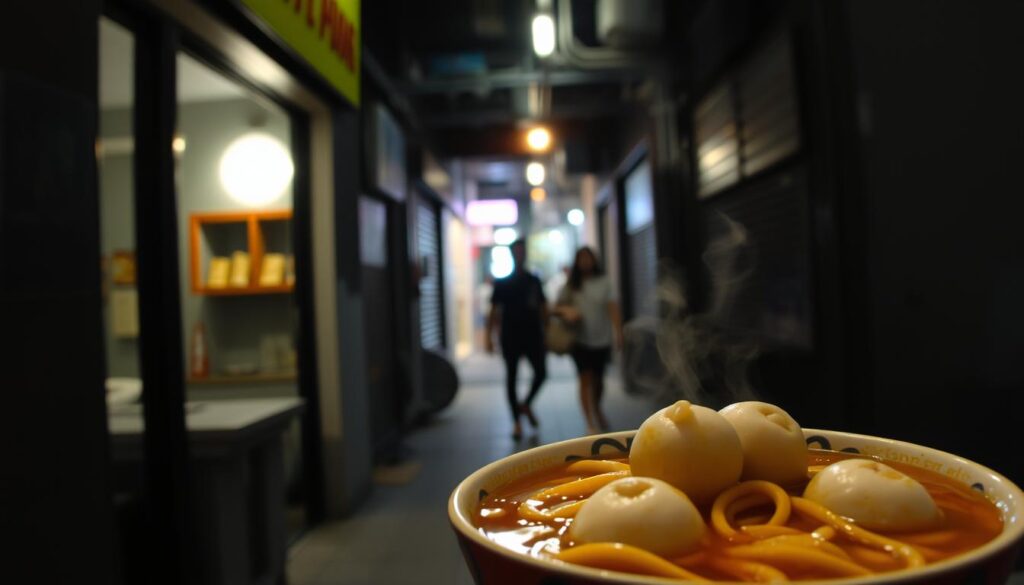
Li Xin Teochew Fishball Noodles
At ION Orchard’s basement, Li Xin brings hawker fare to shoppers. Their premium S$6.50 bowl features yellowtail fishballs—springy with a delicate sweetness. The broth, simmered with dried flounder, is light yet layered.
Regulars rave about the crispy lard bits sprinkled atop flat kway teow. Pair it with their stuffed fish dumplings for a satisfying meal.
254 Fishball Minced Meat Noodle
This Jurong gem dominates the Westside with generous portions. Each bowl includes three massive fishballs—hand-rolled daily. Despite queues, service is brisk.
Their minced meat noodles, tossed in a savory-sweet sauce, balance richness with vinegary tang. A must-try for hearty appetites.
More Underrated Picks
- Nan Yuan (Beo Crescent): Clear soups with a whisper of fried shallots.
- Chao Yang (Eunos): Uses “healthier salt” for a lighter take.
- Mei Ling Market stalls: Unpretentious spots with bold flavors.
| Stall | Specialty | Price Range |
|---|---|---|
| Li Xin | Yellowtail fishballs | S$6.50 |
| 254 Fishball | 3 fishballs + minced meat | S$5.00 |
| Nan Yuan | Clear broth | S$4.00 |
“The best flavors aren’t always where the crowds are—sometimes, they’re in quiet corners.”
Tips for Visiting These Fish Ball Noodle Stalls
Savvy foodies know the secrets to avoiding crowds and maximizing flavor at popular stalls. With some planning, you can skip long waits and discover underrated menu items that elevate your meal.
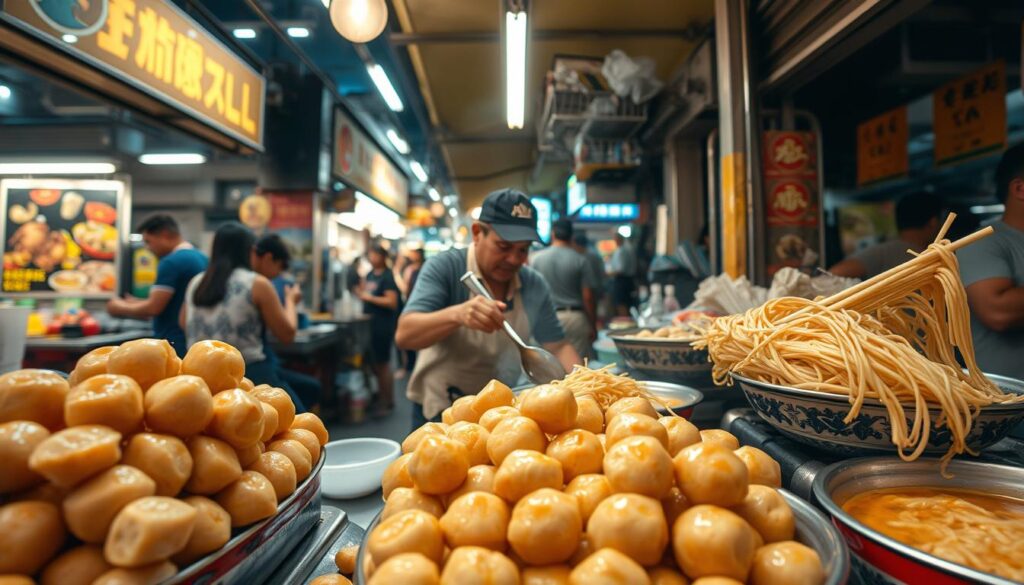
Best Times to Avoid Queues
Arrive 30 minutes before opening hours for spots like Song Heng (5:30 AM–12 PM). Early birds enjoy fresh batches and shorter lines. Ming Fa’s renovated Upper Thomson outlet offers more seating, but nights still draw crowds.
Check stall social media for real-time updates. Many post queue statuses or sudden closures. Pre-ordering via delivery apps like GrabFood can also save time.
What to Order Beyond Fish Ball Noodles
Expand your meal with these must-try add-ons:
- Dumplings: Fuzhou-style versions stuffed with minced pork are rich and savory.
- Fishcakes: Thinly sliced for a delicate texture contrast.
- Prawn rolls or ngoh hiang for crunch.
At Sheng Ji, pair your bowl with their aromatic laksa—a flavorful alternative. Combo orders let you sample more without overordering.
The Cultural Significance of Fish Ball Noodles in Singapore
From pushcarts to Michelin plates, this dish’s journey mirrors Singapore’s growth. What started as Teochew immigrant food in the 1920s now graces hawker centers islandwide. Early vendors like Li Xin began with wooden carts in 1968—today, they operate 13 outlets.
Michelin recognition cemented its status. Hup Kee’s clear broth earned a Bib Gourmand, while Li Xin’s yellowtail fish balls draw food critics. These nods honor the taste and craft behind each handmade piece.
Family recipes battle modern twists. Third-gen stalls like Song Kee preserve 1980s techniques, while cafes fuse it with ramen broths. Yet all share one trait: hawker affordability. A S$4.50 bowl feeds office workers and CEOs alike.
Media spotlight amplifies its charm. Netflix’s Street Food featured its preparation, and blogs dissect perfect taste balances. Even National Day campaigns use it to symbolize unity.
Why does it endure? The answer lies in hawker resilience. As chef Damian D’Silva notes:
“These noodles carry stories—of migration, hard work, and shared joy.”
From school lunches to late-night suppers, it adapts without losing soul. That’s the magic in every steaming noodles dish—a taste of home, always within reach.
Conclusion
Every neighborhood has its own star serving this comforting dish. From Teochew-style broths to spicy Fuzhou twists, the options are as diverse as Singapore itself.
Step beyond your usual hawker center—hidden gems await in Queenstown, Jurong, and even mall basements. Each bowl carries generations of craft, preserving flavors that define local heritage.
Why not create a food trail? Combine Yong Seng’s light broth with Xin Lu’s crispy lard bits for a full experience. Share your finds online and tag fellow food lovers. After all, great noodles taste better when shared.


